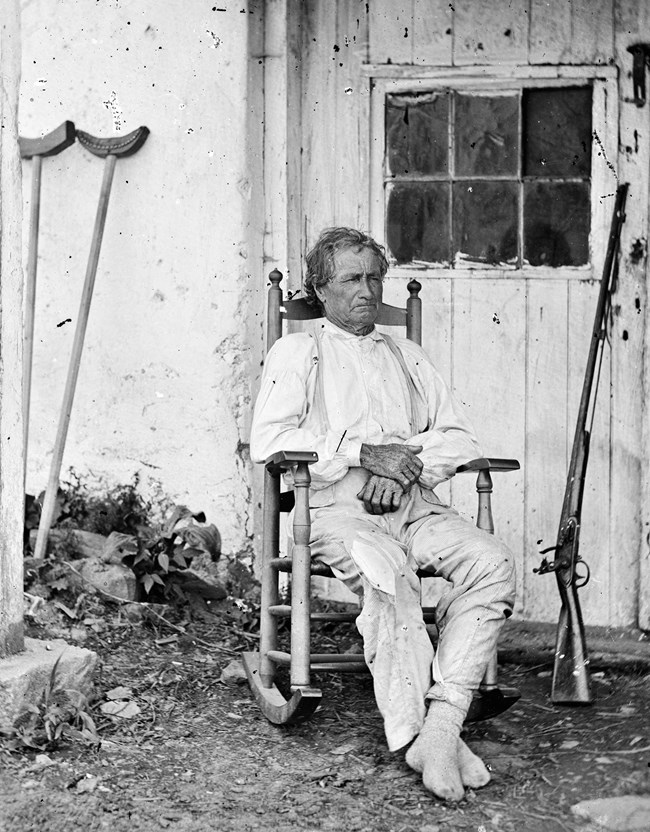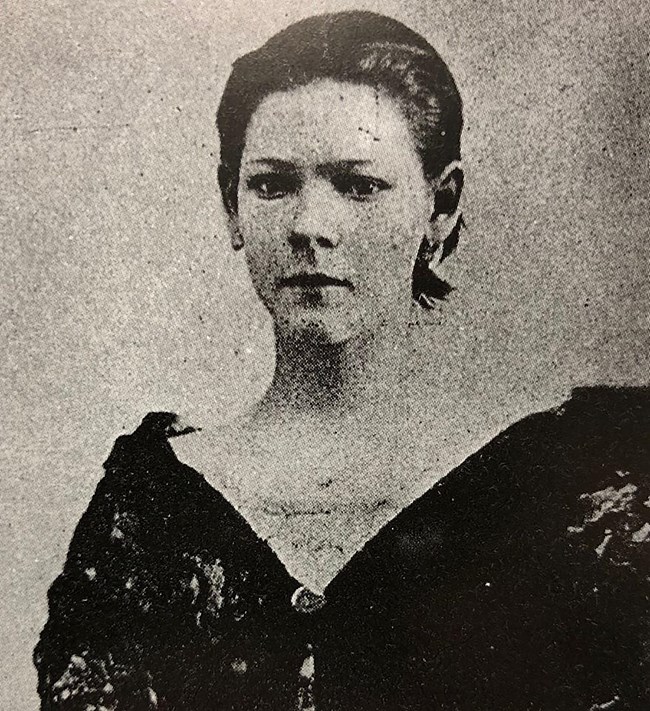Last updated: August 15, 2022
Article
Civilians at Gettysburg

Library of Congress
John Burns
An elderly resident of Gettysburg in 1863, this veteran of the War of 1812 took his musket and powder horn and walked out of town to fight beside United States troops on July 1, 1863. Suffering several wounds, he made his way home where he was left unmolested by Confederate occupiers of the town. Burns became a national hero after the battle and was the first resident of the town that President Abraham Lincoln stated he wished to meet during his trip to dedicate the Soldiers' National Cemetery that November.
Elizabeth Salome (Sallie) Myers
With little warning, this 21-year-old Gettysburg schoolteacher was suddenly thrust into the role of a nurse, tending to injured soldiers at her father's home and in the Catholic church where hundreds of wounded US and Confederate soldiers were hospitalized. She later provided food and nursing assistance at Camp Letterman General Hospital east of town. Despite her claim that she could not stand the sight of blood, Sallie selflessly gave of herself in the hospitals at Gettysburg.
Daniel Skelly
A Gettysburg teenager in 1863, Skelly was a clerk at the Fahnestock Dry Goods Store on Baltimore Street. Skelly watched as Confederate soldiers camped on the street outside of his home while Federal soldiers, cut off from friendly lines, hid in cellars and outbuildings. Assisted by his mother, he helped tend wounded soldiers in homes and churches in town. In 1932 he published "A Boy's Experiences During the Battle of Gettysburg," an outstanding civilian account of the battle from the perspective of an old gentleman who witnessed the true terror of war for the first time in his home town.
Mary Virginia "Jennie" Wade
Confined to her sister's home on Baltimore Street due to the battle raging through and around the town, Jennie Wade was instantly killed by a bullet that passed through two doors and struck her in the back as she mixed bread dough in the kitchen. Buried by United States soldiers in the yard of the home, she was later moved to Evergreen Cemetery where a monument and flag mark her final resting place. Hers was the only civilian death at Gettysburg, made even more tragic when it was discovered that Jack Skelly, her childhood friend and betrothed serving in the 87th Pennsylvania Infantry, had been mortally wounded at Winchester the week before.

National Park Service
Tillie Pierce
This 15-year-old left town with her family to escape the battle only to find herself, in the end, nursing the sick and injured at the J. Weikert farm south of town. She continued caring for wounded soldiers upon returning to the family home on Baltimore Street. Among those she nursed was Colonel William Colvill of the 1st Minnesota Infantry. Tillie later wrote about her experiences in an article, "What a Girl Heard and Saw at the Battle."
David McConaughy
A 40-year-old lawyer and hard-line Republican, McConaughy provided intelligence about Confederate troops to the Federal government during the Gettysburg Campaign. After the battle, he focused his attention on developing the national cemetery until differences with another Gettysburg lawyer forced him out of the project. McConaughy then became a driving force in establishment of the Gettysburg Battlefield Memorial Association, which purchased portions of the battlefield to preserve it as a memorial to the United States Army that fought there.
David Wills
A prominent Gettysburg attorney, Wills was appointed as the state agent to oversee the establishment and construction of the Soldiers' National Cemetery, a final resting place for the United States dead at Gettysburg. Wills also arranged the dedication ceremony, inviting orator Edward Everett to speak and the president to attend. Lincoln accepted and spent the night before the ceremony at Wills' home on the square in Gettysburg.
Dr. J.W.C. O'Neal
A Gettysburg physician and outspoken Democrat, Dr. O'Neal tended to the wounded of both sides during the Battle of Gettysburg. Afterward he maintained a journal that listed identities, regiments and locations of Confederate graves in and around Gettysburg. His work proved invaluable in the removal of Confederate dead to southern cemeteries beginning in 1870.
David Kendlehart
A prosperous businessman in Gettysburg, Kendlehart was president of the city council on June 26 when Confederate Maj. Gen. Jubal Early entered Gettysburg and demanded goods and money from the local government. Kendlehart refused but offered for the stores to be opened so the town's civilians could supply what they could of the general's demands. He later slipped out of town and maintained a low profile during the battle until the morning of July 4 when he entered Federal lines and informed Maj. Gen. George G. Meade of the Confederate withdrawal from the streets of Gettysburg.
